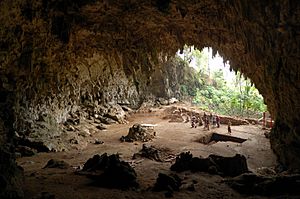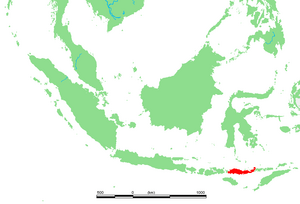Homo floresiensis facts for kids
Quick facts for kids Homo floresiensisTemporal range: Late Pleistocene
|
|
|---|---|
 |
|
| A cast of a Homo floresiensis skull, American Museum of Natural History | |
| Scientific classification (disputed) |
|
| Kingdom: | |
| Phylum: | |
| Class: | |
| Order: | |
| Family: | |
| Tribe: | |
| Genus: | |
| Binomial name | |
| †Homo floresiensis Brown et al 2004
|
|
Homo floresiensis (meaning "Flores Man") is a possible species in the group of humans called Homo. People also call them "hobbits" because they were very small.
Scientists found their remains in 2004 on Flores Island in Indonesia. They found parts of the skeletons of nine different individuals. One of these was a complete skull. The most important thing about H. floresiensis is their small body and small brain size. This is why they got the nickname "hobbits," like the small people in J.R.R. Tolkien's books.
Contents
Discovery of the Flores Man
An Australian and Indonesian team of archaeologists found these remains in 2003. They were looking for signs of how early humans (H. sapiens) traveled from Asia to Australia. They did not expect to find a new human-like species. Finding a nearly complete skeleton of a hominin was a big surprise!
Later digs found seven more skeletons. At first, scientists thought these were from 38,000 to 13,000 years ago. An arm bone, believed to be from H. floresiensis, was dated to about 74,000 years old. The bones were not fossilized and felt like "wet blotting paper". They had to dry out before they could be carefully dug up.
More recent studies of the layers of earth and the age of the bones changed the dates. The newest evidence shows they lived until about 50,000 years ago. Their bones are now dated from 100,000 to 60,000 years ago. Stone tools found with the bones are from 190,000 to 50,000 years ago.
This hominin is special because of its small body and brain. Many stone tools were found in the cave. These tools were small enough for a 1-meter-tall human to use. They are dated from 95,000 to 13,000 years ago. They were found in the same layers as bones of an extinct elephant called Stegodon. The hobbits might have hunted these elephants. Giant rats, Komodo dragons, and other large lizards also lived on the island. Modern humans (Homo sapiens) arrived in the area around 45,000 years ago.
Is it a New Species?
The archaeologists who found the remains, led by Mike Morwood, believe it is a new species. They named it H. floresiensis. They also think H. floresiensis might have lived at the same time as modern humans (Homo sapiens) on Flores Island.
However, not everyone agrees it is a new species. An Indonesian anthropologist named Teuku Jacob thought that the skull (called LB1) belonged to a modern human with microcephaly. This is a condition where the head bones stop growing too early. Another idea was that these individuals might have had a problem with their thyroid gland. This could cause them to be very small due to a condition called myxedema.
Two studies in 2007 found evidence to support H. floresiensis being a separate species. One study looked at three small bones from the hand (carpals). They found these bones were like those of a chimpanzee or an early hominin like Australopithecus. They were different from modern human hand bones. Another study looked at the arm, shoulder, and leg bones and joints. It also concluded that H. floresiensis was more like early humans and apes than modern humans. In 2009, more studies comparing body sizes and family trees also supported the idea that H. floresiensis and Homo sapiens are different species.
Extinction of the Flores Man
Archaeologists believe that Homo floresiensis lived on Flores until at least 12,000 years ago. This makes them the non-modern human species that survived the longest. They lived longer than the Neanderthals (H. neanderthalensis), who died out about 24,000 years ago.
Flores Island stayed separate during the last ice age because of a deep channel of water nearby. Because of this, the scientists who found H. floresiensis think that this species, or its ancestors, must have traveled to the island by water. This might have happened around 100,000 years ago.
The rocks and land on Flores suggest that a volcanic eruption happened there about 12,000 years ago. This eruption might have caused the end of H. floresiensis and other animals on the island. The elephant Stegodon also died out around this time.
Stories of Later Survival
There are local stories on Flores about a small race of people. They are called the Ebu Gogo. These stories describe them as small, hairy cave dwellers who didn't speak much. People say they were still around when the first Portuguese ships arrived in the 1500s. Some even claim they existed as recently as the late 1800s. A paleontologist named Gerd van den Bergh heard about the Ebu Gogo ten years before the fossils were found. On the nearby island of Sumatra, there are also stories of a human-like creature, 1 to 1.5 meters tall, called the Orang Pendek. This creature might be related to H. floresiensis.
Images for kids
-
Skeleton at the Natural History Museum, London
-
Colin Groves and Debbie Argue examining the type specimen
See also
 In Spanish: Hombre de Flores para niños
In Spanish: Hombre de Flores para niños








